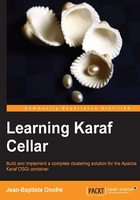
Preface
Apache Karaf has been emerging as the main container for the Open Software Gateway initiative (OSGi) applications. This is mainly because more and more people can see the benefits of OSGi in terms of the reuse of components, versioning, and reduced complexity with real modular applications.
People are also looking for a ready-to-use container that provides all the features expected in a mission-critical and enterprise-ready environment: management, monitoring, and provisioning. It's what Karaf provides, simplifying the development, execution, and production of OSGi applications. However, Karaf is more than a container focused on OSGi; even though it's powered by OSGi, it also supports non-OSGi applications such as Spring or web applications.
In modern architecture, most of the time, we don't have a single instance of the container to be running. In order to provide scalability and high availability, a classic architecture contains multiple container instances that form a farm or cluster of Karaf containers. This architecture brings up new questions: how do you deploy your application components on different instances? How can you target this deployment only on a subset of nodes for staging purposes, for instance? How can you deal with the configuration on different nodes?
Apache Karaf Cellar has been created to address these questions and many more questions.
This book will begin by giving you the means to understand OSGi and Apache Karaf as well as the concepts of a provisioning cluster. By doing so, it will provide the baseline needed before you shift to the advanced usage of Cellar, such as cluster groups or the filtering of cluster events.
This book details the Cellar architecture and the different commands provided by Cellar, from the installation up to the management of clusters.
More than a simple provisioning or synchronization cluster, this book will show you the Cellar runtime features such as Distributed OSGi (DOSGi) and interaction with Apache Camel to create a multinode integration platform.
Using this book, readers will get a detailed understanding, through how-to steps, to set up a cluster of Karaf nodes.